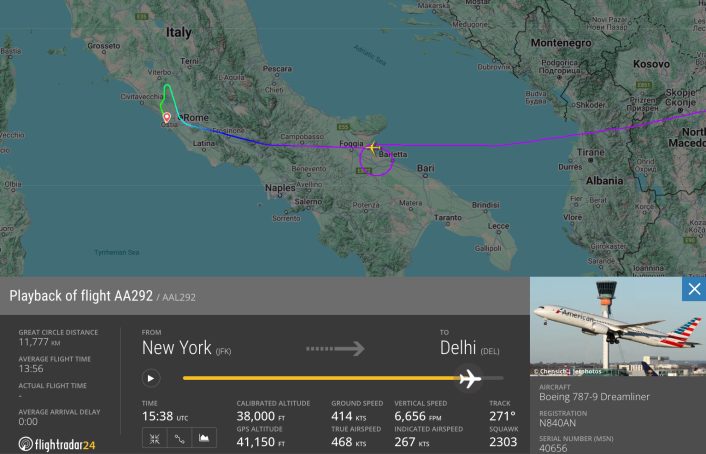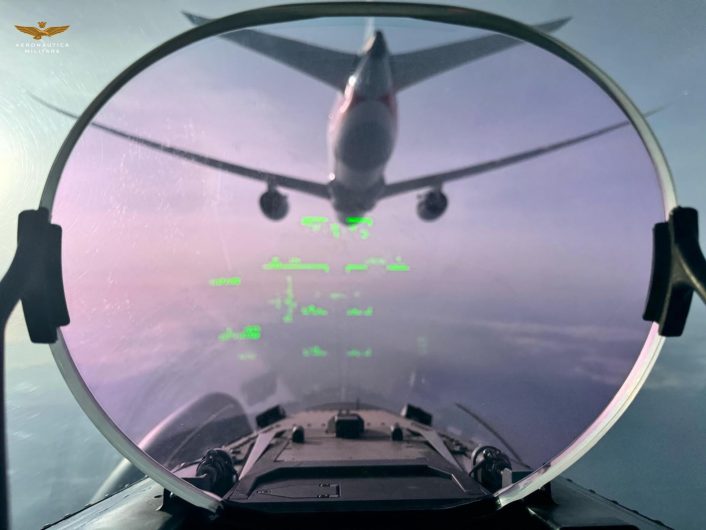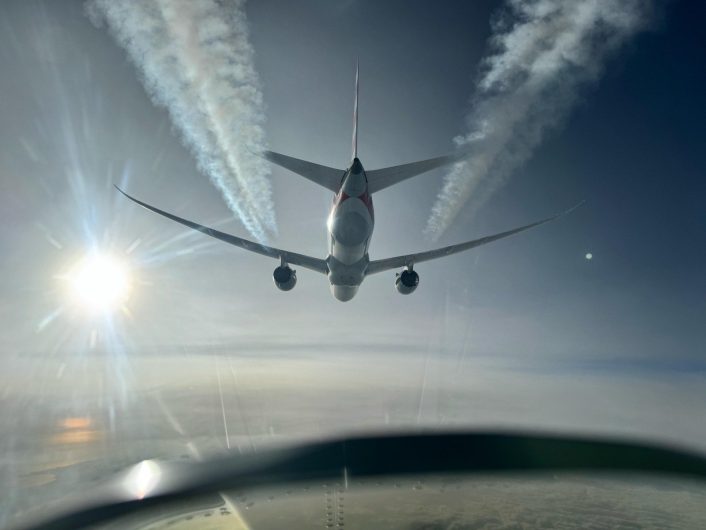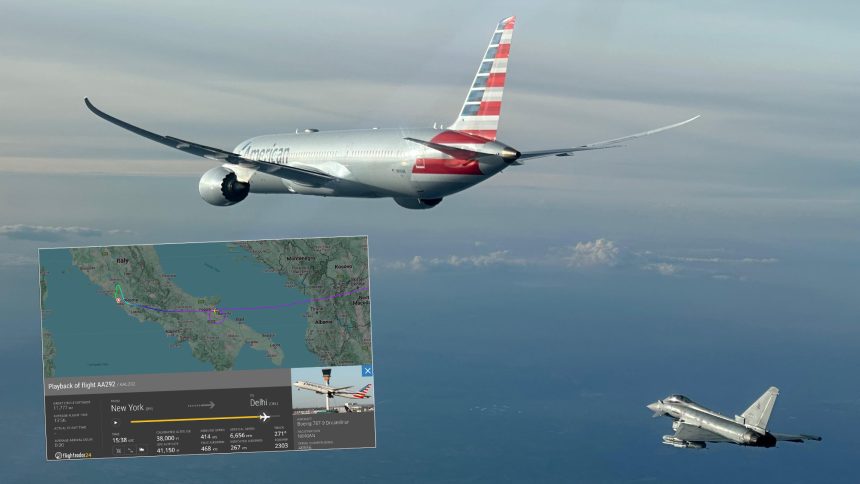We attempt to answer all the questions about AA292, which was intercepted and escorted to landing by two Italian Air Force Eurofighters following a bomb threat.
On Feb. 23, 2025, an American Airlines B787-9 flying from New York to Delhi as AA292 diverted to Rome Fiumicino airport. The Dreamliner aircraft was flying over the Caspian Sea when the decision was made to divert the flight following a request from American Airlines for security checks related to a “suspected bomb threat”.
As the B787 approached the Italian airspace, it was intercepted and escorted by two Eurofighter Typhoon jets (F-2000A, in accordance with the Italian mission design series), scrambled from Grosseto Air Base, home of the 4° Stormo (Wing), all the way to Fiumicino “Leonardo Da Vinci” airport.
Several images of the B787 and its unusual escort were shared online, raising many questions: Why did AA292 divert to Rome instead of landing at a closer airport? Why was one of the Eurofighters flying so close to the airliner? Were the fighters carrying live missiles?
Here’s a video I just filmed from home. American Airlines 292 with two @ItalianAirForce Eurofighters on its way to Rome Fiumicino airport following a bomb threat. https://t.co/3HFHROYj5j pic.twitter.com/SVK7pPWqBy
— The Aviationist (@TheAviationist) February 23, 2025
Many of these questions received partial answers — many of which were at least inaccurate, if not completely wrong, on social media. Therefore, we decided to set the record straight in this article.
Why didn’t AA292 just land at the nearest airport?
When such events happen, the crew and airline decide on the most suitable airport to carry out an emergency landing. The decision takes into consideration several different factors: the airport needs to be equipped with security and emergency response units to handle the threat; the airport needs to have a runway that can operate the B787; last but not least, operational needs.
When deemed safe enough (as in this case), airlines may prefer one airport over another one because it has maintenance facilities and/or availability of flights to rebook passengers. Rome FCO is an airport that is connected to both NYC and India; is an AA-served airport and, thus, was the best option.

Why did the Italian Air Force intercept it?
The Aeronautica Militare (Italian Air Force) ensures surveillance of National Airspace, 24 hours a day, 365 days a year through a complex integrated air defense system that has been linked with those of other NATO countries since peacetime.
The A-Scramble (the Alert take off of the fighters in QRA – Quick Reaction Alert) order was given shortly after 4:00 PM by the CAOC (Combined Air Operations Centre) based in Torrejón, Spain, the NATO body responsible for the area. The two Eurofighters, operating under the control of the 11th Integrated Air and Missile Defense Group (D.A.M.I.) of Poggio Renatico, took off from Grosseto and immediately headed towards the B787. As per standard operating procedure in the event of a bomb alert, the fighters identify the airliner and escort it until landing. They must ensure the civil aircraft does not deviate from its intended route and be ready to intervene if, for instance, it is directed toward a large city or a sensitive location. Needless to say, the fighters may be required to shoot down the airliner as a last resort.
Why did the AA292 flight perform a wide 360-degree turn shortly after entering the Italian airspace?
This is not entirely clear. According to some unconfirmed reports, it was being separated from other traffic at the same altitude, although this seems unlikely. Others suggested that a decision was being made about whether to land the aircraft at another airport instead of Rome Fiumicino.
Were the Eurofighters armed?
Yes, QRA aircraft are always armed. Photos confirm the Eurofighters carried IRIS-T and AIM-120 AMRAAM AAMs (Air-to-Air Missiles) as per standard peacetime QRA configuration.
Was the AA292 aware it was being intercepted?
Yes, the ATC (Air Traffic Control) agency informed the American Airlines flight that it was being intercepted by the Italian Air Force. This is standard procedure. Usually, not too many details are provided to the aircrew, but enough information is given to make them aware of two fast jets in the vicinity (potentially triggering TCAS).

Why was one of the Eurofighters flying so close to the B787’s stern?
The procedure calls for the interceptor to carry out external checks from a position where it can’t be seen from inside the airliner. Some might argue that this is unnecessary if a bomb is hidden inside the cabin. While this is true, authorities can’t be certain about the type of bomb or the intentions of the individuals who may have brought it aboard. Therefore, in such cases, you can’t rule out any possibility, not even the chance that someone might attempt to open a door at low altitude and speed (as they were flying when I saw them, for instance) and throw the bomb onto the city below.
For this reason, especially when flying over or near a large city, the closer the fighter flies to the airliner, the better the chances of spotting any suspicious activity and reacting accordingly before it’s too late.
But what if the B787 exploded mid-air? Wouldn’t the Eurofighter be too close in such a trailing position?
Physics tells us that the movement of the fragments from an aircraft that explodes in flight follows the laws of conservation of momentum and energy. In other words, theoretically, after the explosion, the center of mass of the system would continue moving at the same velocity the aircraft had before the explosion. Naturally, some fragments would be dispersed in the direction of the trailing fighter; drag would slow the fragments down, while gravity would cause some to fall toward the ground. In any case, the Eurofighter in close trail would likely have plenty of time and space to react and move away from the debris cloud.










